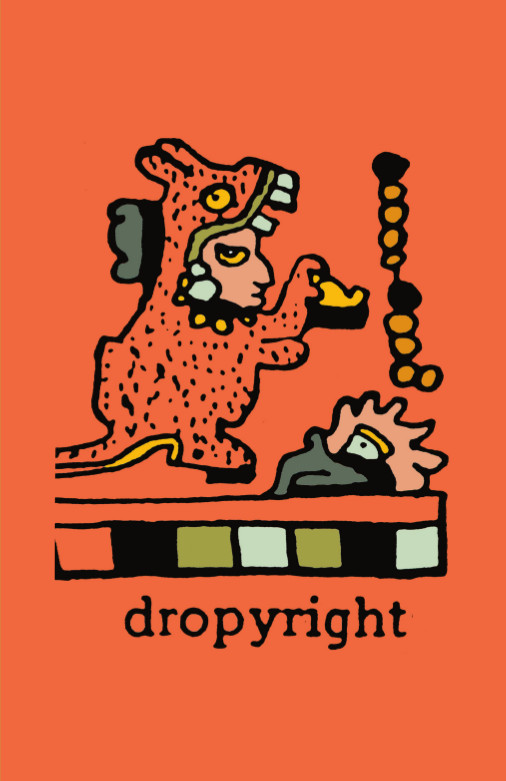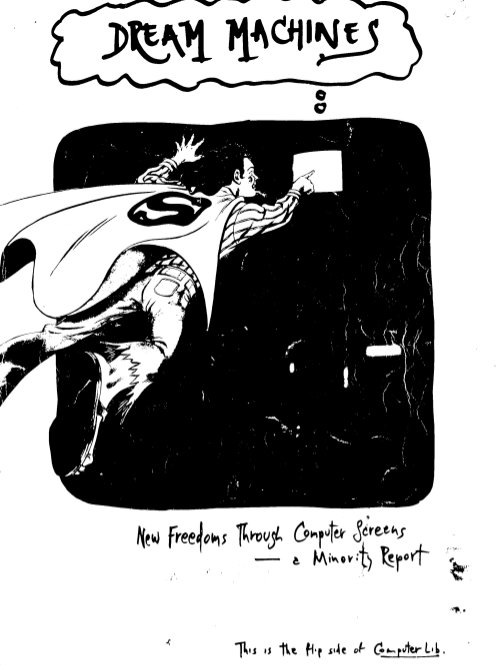The Plagiarist Codex: An Old Maya Information Hieroglyph (1988)
Filed under pamphlet | Tags: · copyright, manifesto, plagiarism

“We have discovered from the barren wastelands of Central America an essential document in the early history of copyist strategies. Thought to have been created toward the end of the classical period of Mayan civilization, 998 A.D., the codex has been translated by a brilliant group of London plagiarists & the esteemed Amendant Hardiker from Wisconsin. Originally published by Plagerizedæ (Sic) Books in 1988 on the occasion of the Festival of Plagiarism held in London, San Francisco & Madison, WI. It is now distributed by Xexoxial Endarchy.” (mIEKAL aND, 1998)
“Something of a manifesto for plagiarism, Wisconsin style. Speaks to the enrichment of cultural dialogue through the reuse of old ideas in new combinations. An extension of collage theory if you will, in that not only are images and texts conflumed in a single multitrack, they are enriched by their new context and the new way they are perceived. The booklet consists of a series of ideograms put next to series of words, parallel text like the Rosetta Stone, serving to transliterate the sense of the pictures. Some, it would seem, are genuinely Maya, others are not. The coinages are exquisite: a useful one is “imagiarism”. Speaks of a communal body of ideas to which everyone has unabashed and inalienable rights. How can you steal whatʼs already yours?” (from the PhotoStatic Magazine review, 1988)
Publisher Plagerizedæ (Sic) Books, Madison, Wisconsin, 1988
Distributed by Xexoxial Editions
ISBN 1440442851
50 pages
via Xerox Sutra Editions
Ted Nelson: Computer Lib / Dream Machines (1974)
Filed under book | Tags: · computing, hardware, history of computing, history of technology, manifesto, media history, software, technology


“Computer Lib is a book by Ted Nelson, originally published in 1974 by Nelson himself, and packaged with Dream Machines, another book by Nelson. The whole publication (referred to as just “Computer Lib” by Nelson and others) had two front covers to indicate the “intertwingling” of the two books, and was republished with a foreword by Stewart Brand in 1987 by a division of Microsoft Press. The book, which is subtitled “You can and must understand computers NOW,” and which Nelson says in the 1987 edition was inspired by Brand’s Whole Earth Catalog, is a spirited manifesto that was inspiring to a generation of DIY computer-lovers. In his book Tools for Thought, Howard Rheingold calls Computer Lib “the best-selling underground manifesto of the microcomputer revolution.”
In Computer Lib, Nelson writes passionately about the need for people to understand computers deeply, more deeply than was generally promoted as “computer literacy,” which he considers a superficial kind of familiarity with particular hardware and software. His rallying cry “Down with Cybercrud” is against the centralization of computers such as that performed by IBM at the time, as well as against what he sees as the intentional untruths that “computer people” tell to non-computer people to keep them from understanding computers.
In Dream Machines, Nelson covers the flexible media potential of the computer, which was shockingly new at the time.” (from Wikipedia)
Publisher Hugo’s Book Service, 1974
132 pages
Reviews: d.h.f. (Byte Magazine, 1975), L.R. Shannon (New York Times, 1988), Vince Juliano (Connecticut Libraries, 1996).
Commentary: Noah Wardrip-Fruin (2003).
Book website
Author
Wikipedia
More information and reviews
PDF (15 MB, updated on 2021-7-9)
Comments (4)Dmytri Kleiner: The Telekommunist Manifesto (2010)
Filed under book | Tags: · capitalism, commons, copyright, cultural production, intellectual property, labour, manifesto, p2p, political economy, venture communism

“In the age of international telecommunications, global migration and the emergence of the information economy, how can class conflict and property be understood? Drawing from political economy and concepts related to intellectual property, The Telekommunist Manifesto is a key contribution to commons-based, collaborative and shared forms of cultural production and economic distribution.
Proposing ‘venture communism’ as a new model for workers’ self-organization, Kleiner spins Marx and Engels’ seminal Manifesto of the Communist Party into the age of the internet. As a peer-to-peer model, venture communism allocates capital that is critically needed to accomplish what capitalism cannot: the ongoing proliferation of free culture and free networks.
In developing the concept of venture communism, Kleiner provides a critique of copyright regimes, and current liberal views of free software and free culture which seek to trap culture within capitalism. Kleiner proposes copyfarleft, and provides a usable model of a Peer Production License.
Encouraging hackers and artists to embrace the revolutionary potential of the internet for a truly free society, The Telekommunist Manifesto is a political-conceptual call to arms in the fight against capitalism.”
The Telekommunist Manifesto is composed of texts that have been extended and reworked by Dmytri Kleiner, from texts by Joanne Richardson, Brian Wyrick and Dmytri Kleiner, 2004–2008.
Publisher Institute of Network Cultures, Amsterdam, October 2010
Network Notebooks series, 3
Peer Production License. Commercial use encouraged for Independent and Collective/Commons-based users.
ISBN 9789081602129
PDF, PDF (updated on 2022-11-12)
Comment (0)
